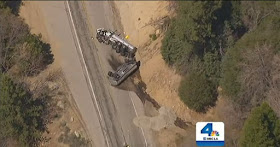THE ROLLOVER RISKS OF TWO-TANK TANKERS ARE TOO GREAT TO CONTINUE TO ALLOW THEM CARRYING HAZARDOUS MATERIALS WITHOUT ADDITIONAL SAFETY MEASURES
http://metroforensics.blogspot.com/2014/11/the-rollover-risks-of-two-tank-tankers.html
The recent rollover of a two-car tanker in Los Angeles reminds how dangerous these two-tank tankers are for carrying flammable liquids.
The fluid slosh can definitely throw you around if you're not expecting it. You have to be smooth with your inputs. If the driver was being stupid/distracted/whatever he could have easily steered/braked too quickly and caused the slosh to tip him over.
Tankers are actually the hardest commercial vehicle to control. Any tanker that has to be completely cleaned out between loads cannot have baffles. Imagine the kind of things that would grow in a tanker full of milk if you could never wash it out. There are also still older tankers out there that move things such as fuel that have baffles today, but did not always have them in the past.
No question its the driver's fault, but he really could have had some surging that contributed to the incident.
============================================
Dynamic Stability of a Vehicle Carrying Bulk Liquid and Driving Over a Bump
The forces generated by the sloshing of bulk liquid carried in tanker trucks can cause accidents. The roll-over tendency of a vehicle can be measured in terms of how many "g" (gravitational acceleration) that vehicle can withstand in cornering. The higher this value, the safer the vehicle. For example, full size passenger cars can withstand around 1.2 g. For a loaded semi-truck the number is 0.4, and for half empty tanker truck it can be as bad as 0.15. Tanker trucks are used for supplying soldiers with water and fuel. The trucks sometimes need to operate on rough terrain at relatively high speeds. This exposes the truck to a roll-over risk. If the tanker is partially empty, the risk of roll-over becomes much higher.
In this project, we simulate sloshing in a tanker truck driving over a bump. The truck is moving at 10 m/s and drives over a bump 40 cm high. The suspension system of the truck absorbs the initial displacement due to the bump and transfers the generated forces to the structure of the truck. The suspension system is composed of two linear springs with different spring constants. The 3D rigid-body dynamic equations are coupled to the finite element formulation of the flow problem and solved simultaneously for the motion of the tanker truck as function of time. The fluid dynamics equations are written in a non-inertial frame to account for this motion. The finite element mesh used consists of 343,560 hexahedral elements and 357,911 nodes. At each time-step, a coupled system of nonlinear equations with 1,704,661 unknowns is solved. The computation was carried out on a CRAY T3E with 32 processors. The frames below show, at different instants, the motion of the truck, sloshing, and fluid pressure. For additional information on sloshing in tanker trucks, see "Sloshing in a Container Subjected to Sudden Deceleration".
The mesh generator and flow solver were developed by the T*AFSM.
References:
1. T.J.R. Hughes, T.E. Tezduyar and A.N. Brooks, "Streamline Upwind Formulations for Advection-Diffusion, Navier-Stokes, and First-order Hyperbolic Equations", Proceedings of the Fourth International Conference on Finite Element Methods in Fluid Flow, University of Tokyo Press, Tokyo (1982).
2. T.E. Tezduyar and D.K. Ganjoo, "Petrov-Galerkin Formulations with Weighting Functions Dependent Upon Spatial and Temporal Discretization: Applications to Transient Convection-Diffusion Problems", Computer Methods in Applied Mechanics and Engineering, 59 (1986) 49-71.
3. T.E. Tezduyar and J. Liou, "Adaptive Implicit-Explicit Finite Element Algorithms for Fluid Mechanics Problems", Computer Methods in Applied Mechanics and Engineering, 78 (1990) 165-179.
4. T.E. Tezduyar, "Stabilized Finite Element Formulations for Incompressible Flow Computations", Advances in Applied Mechanics, 28 (1991) 1-44.
5. T.E. Tezduyar, S. Mittal, S.E. Ray and R. Shih, "Incompressible Flow Computations with Stabilized Bilinear and Linear Equal-order-interpolation Velocity-Pressure Elements", Computer Methods in Applied Mechanics and Engineering, 95 (1992) 221-242.
6. T. Tezduyar, "Advanced Flow Simulation and Modeling", Flow Simulation with the Finite Element Method (in Japanese), Springer-Verlag, Tokyo, Japan (1998).
7. T. Tezduyar, S. Aliabadi and M. Behr, "Parallel Finite Element Computing Methods for Unsteady Flows with Interfaces", Computational Fluid Dynamics Review 1998 (eds. M. Hafez and K. Oshima), World Scientific (1998) 643-667.
8. T. Tezduyar, "CFD Methods for Three-Dimensional Computation of Complex Flow Problems", Journal of Wind Engineering and Industrial Aerodynamics, 81 (1999) 97-116.
9. T. Tezduyar and Y. Osawa, "Methods for Parallel Computation of Complex Flow Problems", Parallel Computing, 25 (1999) 2039-2066.




